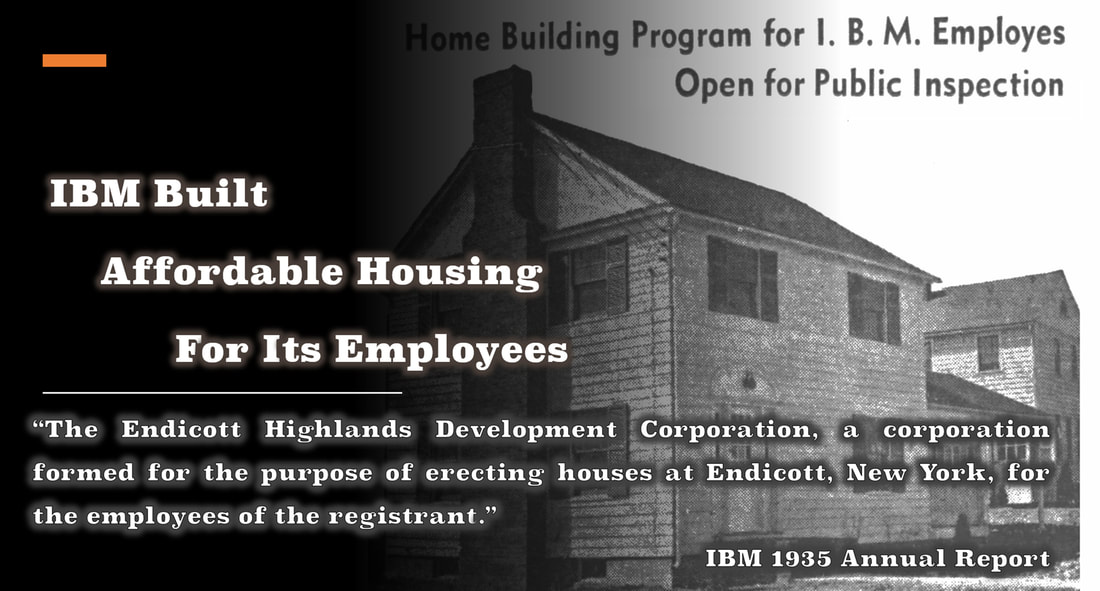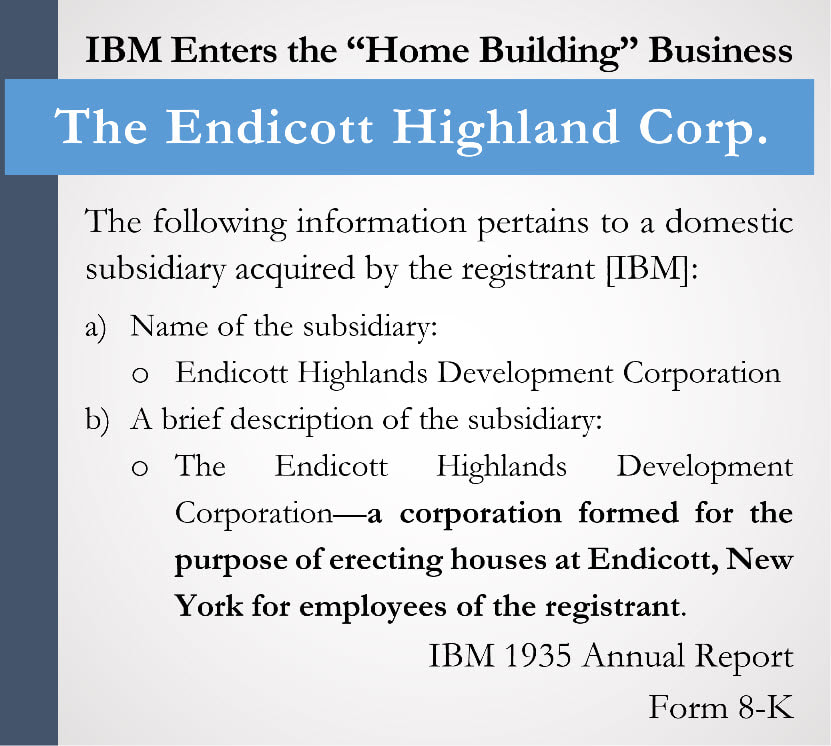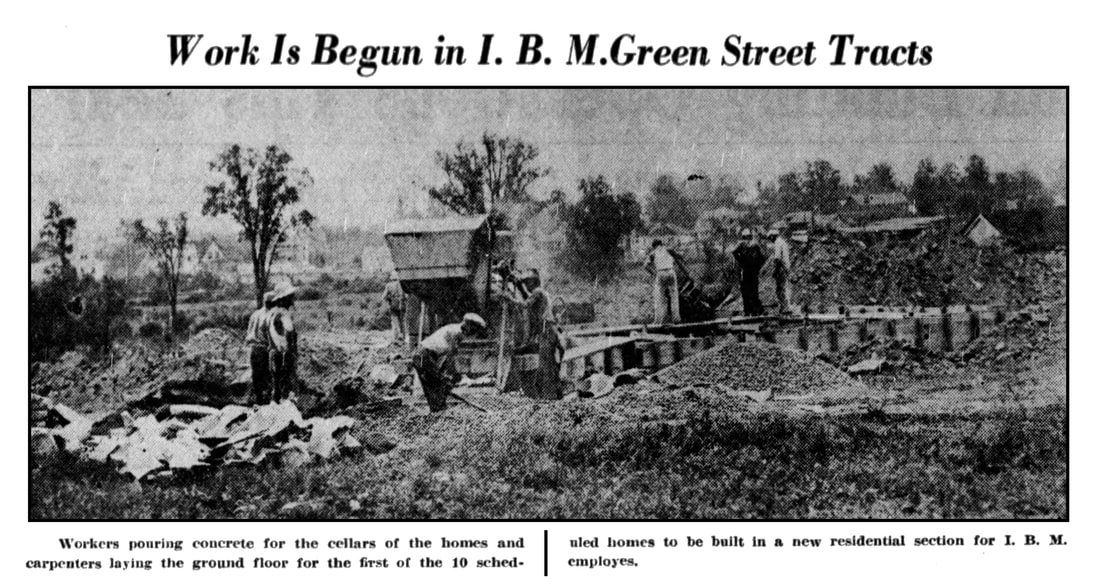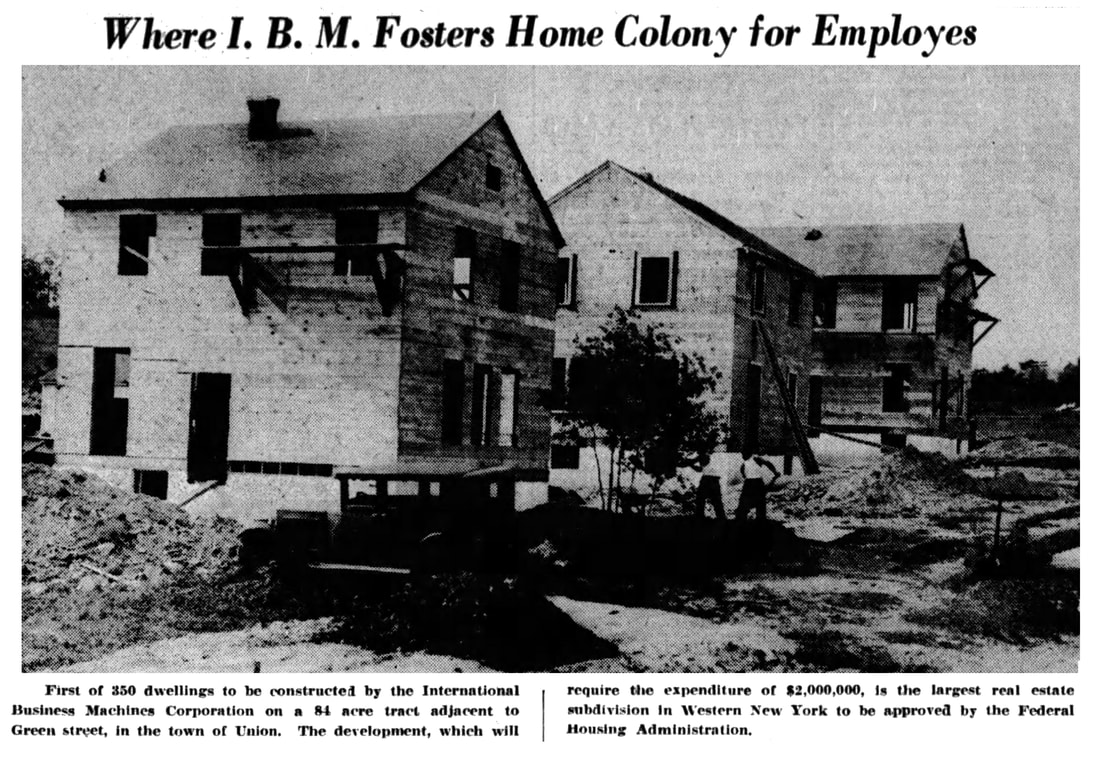IBM's Affordable Housing Project
IBM Builds Affordable Housing for its Employees: 1935-1949
|
|
Date Published: December 12, 2021
Date Modified: January 1, 2024 |
Have American Corporations built homes for their employees?
Yes. One example among many was IBM—International Business Machines—which, under the direction of Thomas J. Watson Sr., built homes for its employees through the Endicott Highlands Development Corporation from 1935–36 and from 1947–49. The corporation was especially active after World War II in providing homes—at cost—for the corporation’s World War II veterans in the Endicott area. [See Footnote for other 20th Century corporations that build homes]
Were the homes that IBM built affordable?
Yes. In 1937, the average yearly pay for an hourly (non-salaried) IBM Endicott Employee was $1,913 or $160 a month to pay a $33 monthly installment on a $3,600 mortgage. Putting this into 2021 dollars, this would be a yearly salary of $38,000 or $3200 per month to pay a $650 monthly installment on a $71,000 mortgage (2021 figures are using the U.S. government’s CPI inflation calculator).
Yes. One example among many was IBM—International Business Machines—which, under the direction of Thomas J. Watson Sr., built homes for its employees through the Endicott Highlands Development Corporation from 1935–36 and from 1947–49. The corporation was especially active after World War II in providing homes—at cost—for the corporation’s World War II veterans in the Endicott area. [See Footnote for other 20th Century corporations that build homes]
Were the homes that IBM built affordable?
Yes. In 1937, the average yearly pay for an hourly (non-salaried) IBM Endicott Employee was $1,913 or $160 a month to pay a $33 monthly installment on a $3,600 mortgage. Putting this into 2021 dollars, this would be a yearly salary of $38,000 or $3200 per month to pay a $650 monthly installment on a $71,000 mortgage (2021 figures are using the U.S. government’s CPI inflation calculator).
IBM Built Affordable Housing for its Employees
- George F. Johnson Issues a Challenge to Tom Watson
- The Formation of IBM’s Endicott-Highland Corporation
- Construction Timeline Highlights
- This Author’s Thoughts and Perceptions
- A Twelve-Year, Detailed, Construction Timeline [Link]
George F. Johnson Issues a Challenge to Tom Watson
In May 1934, George F. Johnson, chief executive of Endicott Johnson Company, issued a challenge to an exceptionally good friend and a fellow tri-cities’ chief executive: Thomas J. Watson, the president and traditional founder of IBM. George F. challenged his friend, Tom, to start “building homes” in the community for IBM employees.
The setting was a First Methodist Episcopal Church membership drive. The Oxford Class of the Endicott-Johnson “Blues” challenged the Oxford Class of IBM “Reds” to increase membership with the highlight of each drive being an attendance contest at the final keynote address by the respective leader of each business organization—George F. Johnson speaking on behalf of the “Blues,” and Thomas J. Watson Sr. speaking on behalf of the “Reds.”
On April 29, 1934, Tom Watson gave his keynote address at the First Methodist Episcopal Church. He looked into the future and stated that “We stand on the threshold of shorter hours and higher wages for everybody and I don’t know of any industrialist who has been progressive in the past who is not looking forward to those conditions.” An impressive start with a positive message; but the following week, George F. Johnson in his keynote stated:
The setting was a First Methodist Episcopal Church membership drive. The Oxford Class of the Endicott-Johnson “Blues” challenged the Oxford Class of IBM “Reds” to increase membership with the highlight of each drive being an attendance contest at the final keynote address by the respective leader of each business organization—George F. Johnson speaking on behalf of the “Blues,” and Thomas J. Watson Sr. speaking on behalf of the “Reds.”
On April 29, 1934, Tom Watson gave his keynote address at the First Methodist Episcopal Church. He looked into the future and stated that “We stand on the threshold of shorter hours and higher wages for everybody and I don’t know of any industrialist who has been progressive in the past who is not looking forward to those conditions.” An impressive start with a positive message; but the following week, George F. Johnson in his keynote stated:
“My thought this morning is to see what we can do for our little town; first of all, let us build homes. … I wish he [Tom Watson] would build a couple hundred homes here. We need at least 500. … In this community we need many things to keep going. The most important is homes. … We want homes, Frank … homes! [Mr. Johnson was addressing the IBM Endicott Resident Manager, Mr. Frank Venner.] The Endicott Johnson Company is going to continue to build homes.”
The Formation of IBM’s Endicott-Highland Corporation
|
In 1934, three houses were constructed. These homes were built by the company’s maintenance department and then sold at cost to employees.
In 1935, IBM added the Endicott Highlands Development Corporation as a wholly owned subsidiary for the purpose of erecting houses for its employees [see sidebar]. Then in September 1935, Walter F. Titus, assistant to Thomas J. Watson, announced the future “development of an eighty-four-acre plot” to be used as a residential area for employees of IBM. It was estimated that 325 lots would be available for new homes. The paper observed that “This is the initial large-scale venture of IBM into the field of aiding employees in home building.” |
Watson arrived in Endicott a few days later to discuss the project and see the land.
|
In June 1936, the Endicott Highland Corporation registered as a real estate business with the county clerk’s office and it was time to get started. By August, workers were pouring concrete for the cellars and laying the ground floors for the first ten residential homes to be built in the new subdivision [see picture]. The director of the Federal Housing Administration (FHA) announced that IBM’s $2,000,000 home building program was the largest real estate subdivision approved by his organization in Western New York.
So, within two years, Tom Watson had put in place an organization and the plans for his corporation to meet George F.’s challenge and build “a couple hundred” homes in the tri-cities area. |
In 1936, IBM through the Endicott Highlands Corporation breaks ground on the first ten homes to be sold to employees.
|
The Binghamton Press described the homes as a Colonial style, frame construction with full basements, attached garages, and six-rooms—kitchen, living, and dining rooms on the first floor, three bedrooms and a bathroom on the second floor. These were to be sold at cost by the corporation to its employees. Six of the ten homes had already been sold, and there was a queue of 134 applications.
|
The plan was to have ten homes continuously under construction—as one was completed, the next house would be started. The homes were estimated to be selling for approximately $3,600 with monthly installments of about $33 including principal and interest.
At times it appeared that IBM and Endicott Johnson—Tom Watson and George F., respectively, were in a contest to outperform each other in supplying homes for their employees. In May 1937, the press noted that Endicott Johnson Company had thirty new homes under construction in West Endicott. Not to be outdone, John M. Demarest, IBM engineer, announced in June that IBM had completed fifteen new homes and had thirteen under construction. |
The first of ten homes a little further along under construction than in the picture above.
|
If the chief executives saw this as a “competition,” it was a friendly competition supporting a wonderful cause—home ownership.
As can be seen in the 1937 picture below, IBM’s Endicott Highlands Community was taking shape.
As can be seen in the 1937 picture below, IBM’s Endicott Highlands Community was taking shape.
A view down Green Street of IBM’s Endicott-Highlands Community in October 1937.
Affordable Housing Construction Timeline Highlights
[See also Detailed Construction Timeline]
- In 1934: George F. Johnson of Endicott Johnson “challenges” Tom Watson to build homes.
- In 1934–35: IBM’s maintenance department builds the company’s first three homes to sell at cost to employees. Its engineers survey an 84-acre site with the potential for 325 homes, and IBM establishes the Endicott Highlands Corporation to build homes for its employees.
- In 1936: IBM starts its first ten homes. Fourteen are completed by May 1937, and the company announces a $2 million program under the FHA for construction of 350 homes—all to be sold at cost to employees.
- In 1940: The IBM resident manager states that since the new subdivision opened, ninety IBM families with approximately three hundred family members have moved into the new subdivision.
- During 1941–42: the country and the corporation face World War II logistical pressures, and material shortages have a significant impact on the extension of essential utilities (gas, water and power) into and throughout the area. Construction slows and, in the spring of 1942, these shortages halt the building of the last seven of a proposed twenty-five homes.
- In 1946: after World War II ends, IBM prioritizes veterans’ applications for any new homes. By year’s end, IBM completes thirty new homes at a cost of more than $200,000 and stated that it had further plans to provide homes for its veterans in 1947.
- In 1947: Endicott Highlands Corporation reports that 137 homes have been completed with thirteen under construction. The corporation sets a goal—depending on the weather—to build homes at a rate of one a week.
- In 1948: IBM ends its Endicott home-building project because it cannot duplicate the benefit in other communities in which the company has factories. United States factories were located in Poughkeepsie, Washington D.C. and San Jose. Although not mentioned, the company would have faced enormous obstacles duplicating this benefit in overseas factories where home ownership was in many cases not yet feasible. The remaining unsold lots—valued at $92,000—were to be sold individually or in block.
This Author’s Thoughts and Perceptions
|
Select this image to see IBM's detailed construction timeline
|
In 1948, The Binghamton Press summed up the home-building efforts of IBM and the Endicott Johnson Company. The two corporations added an estimated 1,000 homes in the Triple Cities area, all of which were built to provide affordable housing for their employees. These projects also provided construction jobs in many difficult years for the area.
This is a surprisingly strong multi-decade run for two of America’s chief executives who constantly challenged each other to do what was best for the communities in which they ran their businesses. |
George F. just needed to get Tom Watson’s attention …
… and the contest was on.
Tom loved a challenge.
… and the contest was on.
Tom loved a challenge.
Footnote: Although IBM and Endicott Johnson Company are premier examples of two corporations that cared about better housing for their employees, they are not unique in the history of the United States of America. Several early twentieth-century corporations preceded them and some even outperformed them:
- Starting in 1916, Firestone Tire Company through Firestone Park Land Company built and sold some 1,000 homes to its employees at cost.
- American Rolling Mill Corporation (ARMCO) built and sold fifty homes at cost in Ashland, Ohio and built the Booker T. Washington school in Middletown, Ohio for the town’s black residents.
- Fairbanks Manufacturing Company of Beloit, Wisconsin built 130 homes.
- George Eastman of Eastman Kodak through the Eastman Savings and Loan Association provided a means for regular and persistent savings, and arranged with local builders to erect suitable, modern houses for employees at a minimum cost.
- George M. McMurtry, President of Apollo Iron & Steel Company, laid out the complete industrial community of Vandergrift, PA around the principle of home ownership.
- Thomas Lynch of Frick Coke Company issued an order to his mine superintendents in twenty settlements with four thousand double houses to “Clean up the towns, grade the streets and put in cement curbs and walks, fence the yards and cover them with sufficient soil to enable the residents to raise flowers and vegetables, … put water in the kitchens, add porches, paint the houses, [and] keep the alleys as clean as the streets.”





